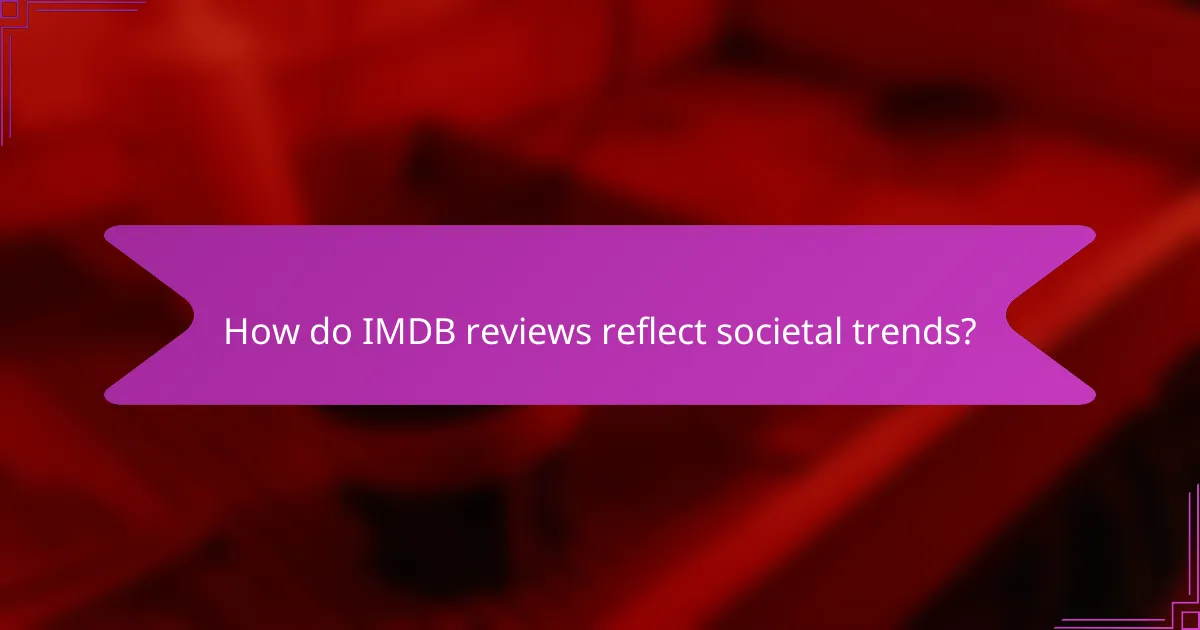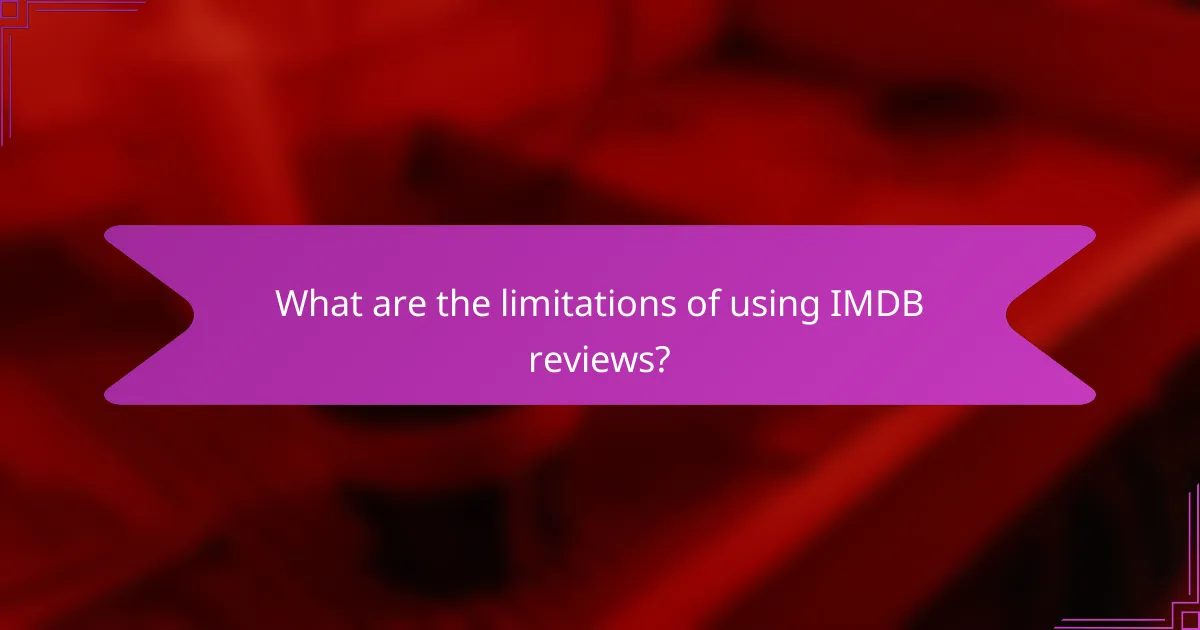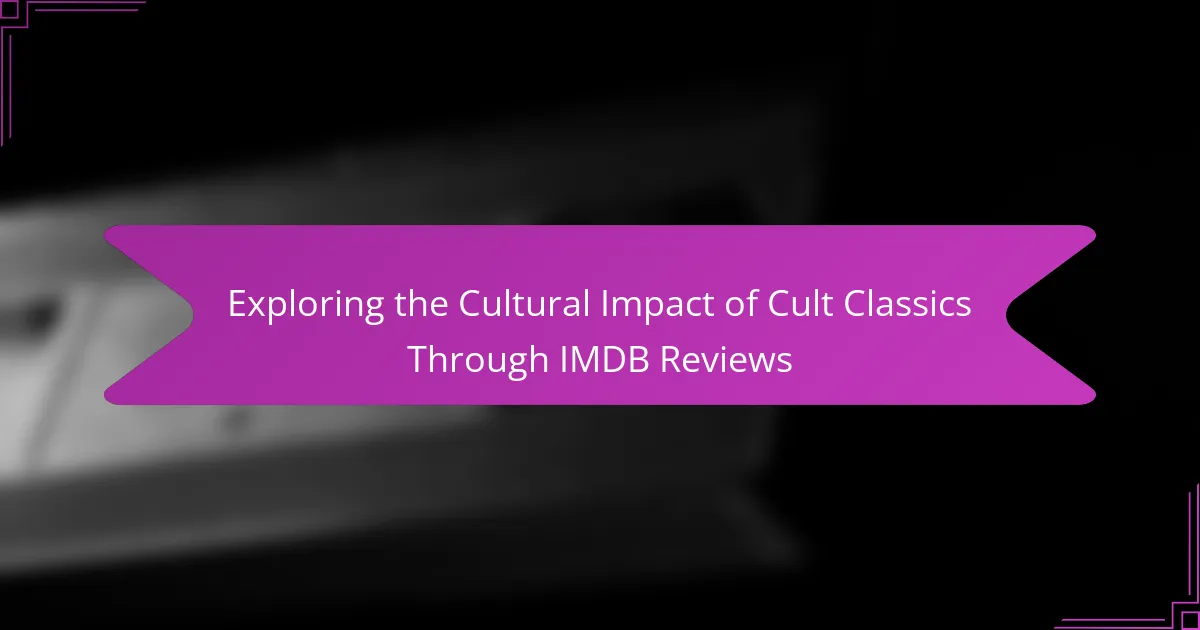IMDB reviews offer a unique lens through which to explore the cultural context of films, capturing audience perceptions and societal values. By analyzing these reviews, one can uncover how various cultures interpret themes and narratives, ultimately enhancing the understanding of a film’s impact on its viewers.

How can IMDB reviews enhance film cultural understanding?
IMDB reviews provide valuable insights into the cultural context of films by reflecting audience perceptions and societal values. Analyzing these reviews can reveal how different cultures interpret themes, characters, and narratives, enhancing overall understanding of the film’s impact.
Contextual insights from user reviews
User reviews on IMDB often highlight personal experiences and cultural references that shape viewers’ interpretations of a film. These insights can reveal regional differences in humor, values, and social norms, which may not be immediately apparent from the film itself.
For example, a film that portrays family dynamics may be received differently in collectivist cultures compared to individualistic ones. By examining the language and sentiments expressed in reviews, one can grasp how cultural backgrounds influence audience reactions.
Analysis of cultural themes in films
IMDB reviews frequently discuss recurring cultural themes, such as identity, tradition, and social issues. Analyzing these themes can help viewers understand the broader societal context in which a film was made and how it resonates with different audiences.
For instance, a film addressing immigration might evoke strong responses in countries with significant immigrant populations. By comparing reviews from various demographics, one can identify common cultural concerns and values that the film addresses, providing a richer understanding of its significance.

What are the key features of IMDB reviews?
IMDB reviews are essential for understanding the cultural context of films as they provide insights into viewer opinions, themes, and societal reactions. Key features include user-generated content and a structured rating system that reflects audience sentiment.
User-generated content
User-generated content on IMDB allows individuals to share their personal experiences and interpretations of films. This diversity of perspectives can highlight cultural nuances and social issues that resonate with different audiences. For example, a film may be praised for its representation of a specific community, while others may critique it for cultural inaccuracies.
When analyzing user reviews, consider the demographics of the reviewers, such as age, location, and cultural background. These factors can significantly influence how a film is perceived and discussed. Engaging with a variety of reviews can provide a more rounded understanding of a film’s impact across different groups.
Rating systems and their implications
The IMDB rating system, which ranges from 1 to 10, allows users to express their overall enjoyment of a film. This numerical representation can be useful for quickly gauging public sentiment but may not capture the complexities of viewer opinions. A film with a high rating might still have mixed reviews that reveal underlying cultural tensions or differing expectations.
When interpreting ratings, pay attention to the number of votes and the distribution of scores. A film with a high average rating but few votes may not reflect widespread approval. Conversely, a film with a lower score but a large number of reviews might indicate a more significant cultural conversation surrounding its themes and execution.

How to analyze IMDB reviews for cultural context?
Analyzing IMDB reviews can reveal significant insights into the cultural context of films. By examining the sentiments and themes expressed in reviews, viewers can better understand how cultural backgrounds influence perceptions of a movie.
Identifying recurring themes
To identify recurring themes in IMDB reviews, look for common phrases or ideas that multiple reviewers mention. Pay attention to the emotional responses elicited by specific scenes, characters, or plot points. For instance, if many reviewers highlight themes of family or community, it suggests that these elements resonate strongly within the cultural context.
Consider creating a list of these themes as you read through reviews. This can help you visualize which aspects of the film are most impactful to audiences from different backgrounds. Themes such as love, sacrifice, or social justice often reflect broader societal values and issues.
Comparative analysis of cultural references
Conducting a comparative analysis of cultural references in IMDB reviews can deepen your understanding of a film’s context. Look for mentions of specific cultural symbols, traditions, or historical events that reviewers reference. This can highlight how a film aligns or contrasts with cultural norms and expectations.
For example, if a film set in the U.S. is compared to a similar film from Europe, reviewers might discuss differences in storytelling techniques or character development. Noting these comparisons can provide insights into how cultural backgrounds shape narrative styles and audience expectations.

What tools can assist in analyzing IMDB reviews?
Several tools can enhance the analysis of IMDB reviews, helping to uncover cultural context and audience sentiment. Text analysis software and sentiment analysis tools are particularly effective for extracting meaningful insights from large volumes of reviews.
Text analysis software
Text analysis software processes written content to identify patterns, themes, and trends within IMDB reviews. These tools can help you categorize reviews based on various criteria, such as genre, themes, or character analysis. Popular options include NVivo and RapidMiner, which allow for qualitative and quantitative analysis.
When using text analysis software, focus on key features like keyword extraction and topic modeling. For instance, you might find that certain films evoke discussions around specific cultural themes, such as identity or morality. This can guide your understanding of how films resonate within different cultural contexts.
Sentiment analysis tools
Sentiment analysis tools evaluate the emotional tone of IMDB reviews, categorizing them as positive, negative, or neutral. These tools, such as MonkeyLearn and Lexalytics, use natural language processing to analyze the language used in reviews, providing insights into audience perceptions and feelings about a film.
To effectively use sentiment analysis tools, consider the overall sentiment score alongside specific keywords. For example, if a film receives a high number of positive reviews mentioning “diverse” or “innovative,” it may indicate a strong cultural impact. Be cautious of potential biases in the data, as sentiment can vary widely based on demographic factors or regional perspectives.

How do IMDB reviews reflect societal trends?
IMDB reviews serve as a lens through which societal trends can be observed, revealing shifts in audience values, preferences, and reactions to cultural phenomena. By analyzing these reviews, one can gain insights into how films resonate with contemporary issues and collective sentiments.
Shifts in audience preferences
Audience preferences often evolve based on changing cultural norms and values, which can be tracked through IMDB reviews. For instance, films that promote diversity and representation may receive more favorable reviews as society increasingly values inclusivity. This shift can be seen in the rise of films featuring strong female leads or stories centered around underrepresented communities.
To understand these shifts, consider looking for patterns in the language used in reviews. Terms like “authentic,” “relatable,” or “inspiring” often indicate a positive reception aligned with current societal values. Conversely, negative reviews may highlight a disconnect between the film’s themes and audience expectations.
Impact of cultural events on film reception
Cultural events, such as social movements or significant political changes, can significantly influence how films are received and reviewed on platforms like IMDB. For example, films released during times of social upheaval may be scrutinized for their relevance to ongoing issues, leading to polarized reviews based on viewers’ personal experiences and beliefs.
When analyzing reviews, pay attention to references to current events or societal issues. Reviews that mention movements like Black Lives Matter or Me Too often reflect how these events shape audience perceptions and expectations of films. This context can provide deeper insights into why certain films resonate more strongly at particular times.

What are the limitations of using IMDB reviews?
IMDB reviews can provide insights into the cultural context of films, but they have notable limitations. These include potential biases from reviewers and inconsistency in the quality of the reviews, which can skew perceptions and understanding.
Potential biases in user reviews
User reviews on IMDB often reflect personal preferences and cultural backgrounds, which can introduce biases. For instance, a film that resonates with one demographic may receive negative feedback from another due to differing values or expectations.
Additionally, the anonymity of online reviews can lead to extreme opinions, where users either overly praise or harshly criticize films without providing balanced perspectives. This can mislead viewers about a film’s true cultural significance.
Inconsistency in review quality
The quality of IMDB reviews varies significantly, with some being well-articulated and insightful while others are vague or poorly written. This inconsistency can make it challenging to gauge the overall sentiment towards a film accurately.
Moreover, the sheer volume of reviews can overwhelm users, making it hard to identify which reviews are credible. It’s advisable to look for reviews that provide specific examples and context rather than relying solely on star ratings or general comments.

How to integrate IMDB reviews into film studies?
Integrating IMDB reviews into film studies involves analyzing user-generated content to gain insights into cultural perceptions and societal values reflected in films. By examining these reviews, researchers can uncover trends, themes, and audience reactions that contribute to a deeper understanding of a film’s impact and relevance.
Case studies of specific films
Case studies can provide a focused lens on how IMDB reviews reflect cultural context. For instance, analyzing the reviews of films like “Parasite” reveals how audiences from different backgrounds interpret its themes of class struggle and social inequality. Reviews often highlight specific cultural references that resonate differently depending on the viewer’s own experiences.
Another example is “Black Panther,” where IMDB reviews showcase a mix of pride and critique from various cultural perspectives. The film’s representation of African culture sparked discussions that can be traced through user comments, illustrating how cultural identity influences reception.
Comparative studies across different cultures
Comparative studies using IMDB reviews can reveal significant differences in how films are perceived across cultures. For example, a romantic comedy like “Crazy Rich Asians” may receive positive reviews in Western countries for its representation of Asian culture, while audiences in Asian countries might critique its portrayal of wealth and privilege.
To effectively conduct these studies, researchers should categorize reviews by region and cultural background, noting variations in themes and sentiments. This approach can highlight how cultural values shape audience interpretations and preferences, providing a richer understanding of global cinema.

What emerging trends are shaping film reviews?
Emerging trends in film reviews are increasingly influenced by social media, audience engagement, and the rise of streaming platforms. These factors are transforming how reviews are created, shared, and consumed, reflecting broader cultural shifts in film appreciation.
Social Media Influence
Social media platforms have become vital for film reviews, allowing users to share their opinions instantly and widely. This shift means that traditional critics are now competing with everyday viewers, whose reviews can gain significant traction and impact a film’s reception.
For instance, a film might receive a surge in popularity based on viral social media posts, often overshadowing professional critiques. This democratization of film commentary can lead to diverse perspectives but may also result in misinformation or overly emotional reactions.
Audience Engagement
Engagement with audiences is more interactive than ever, with platforms encouraging viewers to rate and comment on films. This trend allows for a more nuanced understanding of what resonates with different demographics, as reviews often reflect personal experiences and cultural backgrounds.
For example, films that address social issues may receive varying reviews based on the viewer’s own context, highlighting the importance of cultural relevance in film appreciation. Filmmakers and marketers are increasingly attentive to these audience insights when promoting their work.
Streaming Platforms and Accessibility
The rise of streaming services has changed how films are distributed and reviewed, making them more accessible to a global audience. This accessibility leads to a broader range of reviews, as viewers from different cultures can share their thoughts on the same film.
As a result, films that may have been niche or regional are now subject to international scrutiny, often leading to varied interpretations. Understanding these cultural contexts is essential for grasping the film’s impact and significance in different societies.



